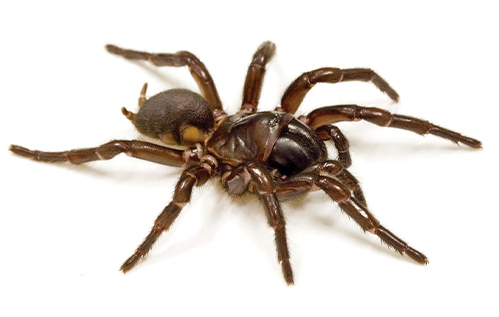There are an estimated 150,000 animal species that have evolved venom. Some are familiar, such as snakes, bees, scorpions, and spiders. But there are also venomous lizards, sea anemones, cone snails, and even a few mammals, like the duck-billed platypus with its venom-bearing ankle spurs [1].
“Venom has evolved independently over 125 times across the animal kingdom,” says Brian Fry, a biologist at the University of Queensland whose laboratory studies a range of venomous animals (Figure 1). “That’s far more times than other key evolutionary innovations, like flight.”
Venom is a specialized type of poison that is injected through a bite or sting. A single venom is a chemical cocktail that may contain dozens, even hundreds, of toxins. These toxins have been honed over hundreds of millions of years of evolution to attack specific aspects of the target’s vital bodily functions. This means that venoms could yield a huge number of chemicals that act on the blood, muscles, or nervous system.
Comparatively few of the thousands of animal venoms that exist in nature have been analyzed for their potential medical value. Some venom-inspired medicines are already in use, and others show promise, for treating chronic pain, heart conditions, blood clots, diabetes, and more. Now, advances in technology are allowing scientists to discover and screen more venoms and use them to create something that heals, rather than kills.

(Photo courtesy of B. Fry.)
Bite that heals
Venoms possess a few properties that make them attractive as potential medicines, says Christine Beeton, an immunologist at the Baylor College of Medicine (Figure 2). “A single venom can have hundreds of components, a huge library of compounds,” she says. “Venoms provide the specificity and potency you want in a drug. They often need optimization in the laboratory, but over many millions of years of evolution, a lot of the work has already been done.”
The first pharmaceutical derived from animal venom, and an “early and unrivaled success story,” according to Fry, is captopril. Captopril is an antihypertensive approved by the U.S. Food and Drug Administration (FDA) in 1981. “If you know anyone taking high blood pressure medication, they are taking captopril or one of its derivatives,” says Fry. “This was developed from the venom of the Brazilian lancehead viper 45 years ago, but it remains today a 10 billion dollar a year market.”

This viper’s venom contains a peptide that disrupts the angiotensin-converting enzyme (ACE), preventing release of a hormone that causes blood vessels to constrict. The development of this toxin into a drug introduced a completely new class of medication, the ACE-inhibitors. Since captopril, the FDA has approved nine more venom-derived drugs, with the most recent one in 2012 [2].
Two of these drugs are also derived from snake venom and used to treat heart conditions. Similar toxins from the southeastern pygmy rattlesnake and the saw-scaled viper stop blood from clotting. The drugs based on these toxins, eptifibatide and tirofiban, respectively, are used to prevent the blood clots that can cause heart attacks and strokes [1].
The most recent venom-derived drug on the market is exenatide, based on a toxin in the venomous saliva of the gila monster. These lizards are able to eat as few as three big meals a year, yet their blood sugar remains stable. In the 1990s, researchers discovered a component in the gila monster’s venom that works like a hormone to stimulate insulin release when blood sugar levels rise. Exenatide, an injectable drug based on the toxin, helps people with diabetes produce their own insulin and lose weight [3].
Investigating venoms
The first venoms to be investigated for potential medicinal use were those that produced observable effects on humans. Early studies required knowledge of the venom’s clinical effects and large amounts of venom, so large species with easily extracted venoms, like snakes, were typically the focus. Today, advances in genomics, proteomics, and transcriptomics—branches of molecular biology that study DNA, proteins, and their messenger molecules—have given scientists more ways to understand venoms and their targets [4].
With these new tools and approaches, “we can analyze the venom of even very tiny animals, such as centipedes and assassin bugs, in a way that has completely changed the game,” says Glenn King, a biochemist at the Institute for Molecular Bioscience, University of Queensland (Figure 3). “In the last few years, we have started to see new venomous animals studied for the first time.”
As part of an effort to discover new compounds to treat human disorders, King has amassed what he believes is the largest collection of invertebrate venoms in the world. “We have venoms from over 500 species,” he says. “When we find an interesting drug target, we can screen those venoms against that target and see if any of them have molecules that might look promising.”
Mandë Holford, a chemical biologist at CUNY Hunter College, the American Museum of Natural History, and Weill Cornell Medicine, is also taking advantage of cutting-edge technologies to probe venoms (Figure 4). She works on discovering novel peptides from venomous marine snails that could be used to make medicines for pain and cancer.
One development that Holford is excited to see enter the field is the use of organoids, 3D representations of organs that are derived from stem cells. With the growing popularity of “mini-brains,” “mini-hearts,” and other organoids (usually derived from human or mouse cells), Holford’s thoughts turned to the possibility of “mini-venom glands.”

She says that having realistic model systems that can simulate how venoms are made would help scientists like her figure out how to better optimize venoms for use in human medicine. She points to ziconotide, an FDA-approved drug based on a peptide from cone snail venom. It is used to treat chronic severe pain in HIV and cancer patients but, since it does not cross the blood-brain barrier, it must be administered by spinal tap.
“Perhaps if we knew more about how this peptide is expressed in the venom gland, we could manipulate it so that it had ways of being peripherally active,” Holford says. “Venom is a molecular innovation, so until we can apply molecular tools to investigate it at a genetic level, we’ll just be tinkering with the amino acids, which are the final product. If we go a little bit more upstream and look at how the sausage is made, maybe we’ll get more insight into why venoms function the way they do and why they are so effective.”
In the pipeline
With so many venom toxins in nature left to explore, where might the next venom-inspired medicines come from?
Tozuleristide, a diagnostic drug derived from the venom of the Israeli deathstalker scorpion, is now in phase II clinical trials. A component of the venom, called chlorotoxin, binds to tumor cells. Researchers at the Fred Hutchinson Cancer Research Center re-engineered this protein and added a fluorescent tag to it, resulting in a diagnostic tool that seeks out and illuminates tumors. Tozuleristide helps surgeons gauge, in real time, where a tumor ends and healthy cells begin. The drug has gone through safety testing and early clinical trials to image brain tumors in children and may be only a few years away from possible FDA approval [2].

Another drug candidate builds on work by King’s research group, who identified a small protein in the venom of the Fraser Island (K’gari) funnel web spider that can reduce damage to the brain after stroke (Figure 5). King and his colleagues recently tested the protein, called Hi1a, on heart cells to investigate its usefulness in preventing damage from heart attacks [5].
“We have just started a company to take this molecule into clinical trials within the next two to three years,” says King. “For heart attack victims, we envision Hi1a could be administered by first responders in the ambulance and prevent much of the damage from loss of blood flow or lack of oxygen that occurs in stroke and heart attack.”

Beeton’s research has also yielded a pharmaceutical now in phase II clinical trials. The drug, dalazatide, is derived from a peptide in sea anemone venom called stichodactyla toxin (ShK). This peptide binds to a potassium channel named Kv1.3. This channel happens to be upregulated in certain white blood cells involved in a number of autoimmune diseases, including multiple sclerosis and rheumatoid arthritis. Rather than dampening the entire immune system like existing drugs, dalazatide targets the cells involved in the autoimmune reaction, selectively blocking the Kv1.3 channel.
Although Beeton has been buoyed by seeing this drug come so far, she says that one drawback is that it, like many venom-derived drugs, must be injected. To get around this, Beeton has begun to work with microbiologist colleagues at the Baylor College of Medicine to bioengineer a probiotic bacterium able to produce the toxin of interest.
“We have given it to rats with the model of rheumatoid arthritis and the bacterium produces the toxin in the gut, gets it into circulation, and reduces disease severity,” says Beeton. “We are just starting, but it is exciting because, down the road, we envision that we could take these modified bacteria that produce therapeutic toxins and give them in a pill.”
Very venomous world
Holford says the future for the venom field will depend on the interdisciplinary efforts of different kinds of scientists working together to answer complex questions and produce innovations.
“Initially, it was a field of natural products chemists, but now we have many specialists all studying different aspects of venom,” she says. “We need ecologists to understand how venom works in its natural environment. We need chemists to identify the compounds. We need biologists to manipulate the genes.”
According to King, the pace of venom research is accelerating—and there is plenty more to learn. Recently, he and his team estimated that about 15% of all extant species are venomous, though they believe that is likely an underestimation. “We think that at least 30% of animal species may be venomous,” he says. “That sounds high, but most of the world is invertebrate, and a large number of these animals—insects, arachnids, jellyfish, sea anemones, and so on—are venomous.
“So a very large fraction of the entire population living on the planet is venomous. When you look at how much of that has been examined, it’s less than 1%. There is so much more to explore.”
References
- K. Nightingale, “The bite that cures: How we’re turning venom into medicine,” Sci. Focus, Jul. 2019. [Online]. Available: http://www.sciencefocus.com/article/nature/bite-cures-how-we%E2%80%99re-turning-venom-medicine
- A. McDermott, “News feature: Venom back in vogue as a wellspring for drug candidates,” Proc. Nat. Acad. Sci. USA, vol. 117, no. 19, pp. 10100–10104, May 2020, doi: 10.1073/pnas.2004486117.
- J. S. Holland, “The bite that heals: Scientists are unlocking the medical potential of venom,” Nat. Geographic, Feb. 2013. [Online]. Available: https://www.nationalgeographic.com/magazine/article/venom
- C. Wilcox, “Poison as medicine,” Discover, Mar. 24, 2015. [Online]. Available: http://discovermagazine.com/2015/april/00-poison-medicine
- University of Queensland, “Repairing hearts with deadly spider venom: Study,” Jul. 19, 2021. [Online]. Available: http://www.sciencedaily.com/releases/2021/07/210719103103.htm


